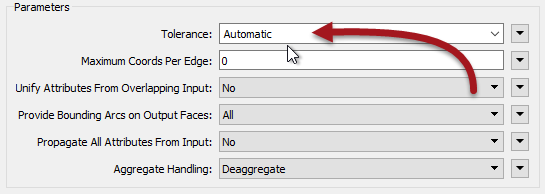Tolerance Parameters
FME2018 introduces a tolerance parameter to many existing transformers, and one new transformer:
- AreaGapAndOverlapCleaner
- AreaOnAreaOverlayer
- Clipper
- Dissolver
- FeatureMerger
- Generalizer
- Intersector
- LineOnAreaOverlayer
- LineOnLineOverlayer
- Snapper
- Tiler
- TopologyBuilder
The AreaGapAndOverlapCleaner is, of course, the new transformer. It's a direct replacement for the SliverRemover. The Snapper already had a tolerance parameter, but that has been updated to use this new functionality.
So why these transformers? Because it's a set of transformers that use a common piece of code. That code was updated to allow a tolerance to be applied and was exposed as a new parameter:

The tolerance parameters have three different options:
- None
- Automatic
- Custom Value

None means the transformer operates as it always did in FME; without any tolerance applied. The operation will be carried out using strict matches of coordinates. This is the default value (for 2018.0 at least).
Automatic means FME will decide upon a tolerance. Here FME is trying to resolve minor issues with coordinates, such as coordinate precision and rounding.
Custom Value means the user will enter a tolerance. The user is trying to resolve any issues they believe can be fixed through tolerance, such as bad geometry.
Collapsed Ports
Some transformers with the new tolerance setting have a Collapsed output port. This is for features whose size is smaller than the tolerance value, and which therefore collapse to a single point.
| TIP |
| Because the Automatic mode is newer technology, its performance in many cases is actually faster than having no tolerance at all! |